Many of the following technical specifications appear on datasheets for pressure transducers and similar devices. Here we review their technical definitions and relationships.
Root Sum Squares (RSS): accuracy of a pressure transducer is calculated by taking the square root of non-linearity + hysteresis + non-repeatability.
For Example:
[Non-Linearity: (±0.1%)2 = 0.01%] + [Hysteresis: (±0.05%)2 = 0.0025%] + [Non-Repeatability: (±0.02%)2 = 0.0004%] = 0.0129%
√0.0129% = ±0 .11% FS at constant temperature
Non-Linearity
The relationship of a calibration curve to a specified straight line.
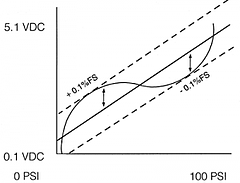
Hysteresis
The maximum difference in output at any pressure value within the specified range, when the value is approached with increasing and decreasing pressure.
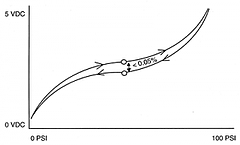
Non-Repeatability
The ability of a transducer to reproduce output readings when the same pressure value is applied to it consecutively, under the same conditions, and in the same direction.
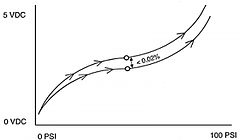
Long-Term Stability
The ability of a transducer to reproduce output readings obtained during its original calibration at room conditions for a specified period of time.
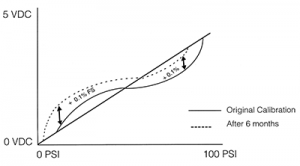
Zero Offset
Zero output is factory set to within a certain % of full scale. Results in a shift up or down of the calibration curve.
Does not affect linearity or accuracy.
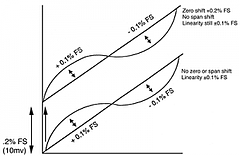
Span Offset
Span output is factory set to within a certain % of full scale. Results in a change in the slope of the curve.
Does not affect linearity or accuracy.
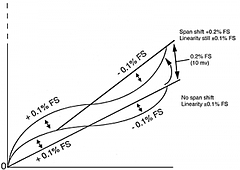
Thermal Effects
The change in the zero and span output that occurs due to temperature changes.
Thermal Zero Shift: < +/- 0.004%/°F (0.0072%/°C)
Thermal Span Shift: < +/-0.003%/°F ( 0.0054%/°C)
Example: Temp Range -10°F to +130°F ( -23°C to +55°C)
Max temp. change from 70°F (21°C) = 80°F (44°C)
80°F X .004%/°F = .32% FS DZ/DT
or 44°C X .0072%/°C = .32% FS DZ/DT
80°F X .003%/°F = .24% FS DS/DT
or 44°C X .0054%/°C = .24% FS DS/DT
CLICK HERE to learn more about how to calculate Total Error Band (TEB).




